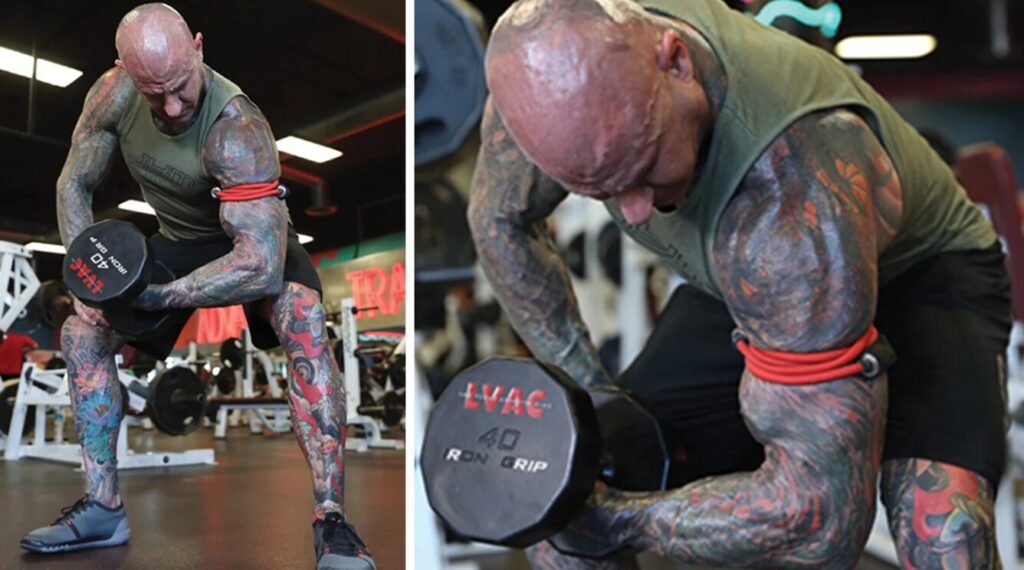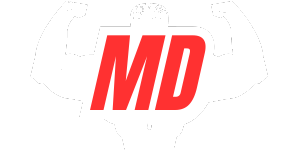Occlusion training builds muscle with just 20-30% of your max weight by restricting blood flow to create metabolic stress. Apply bands at 7/10 tightness on upper limbs for 15-20 minutes maximum per session. For best results, use BFR for isolation exercises after heavy compounds, limit to 2-3 weekly sessions per muscle group, and guarantee 48-72 hours of recovery between sessions.
The perfect combination of pressure, frequency, and recovery opens up hypertrophy without the joint stress.
The Science Behind Occlusion Training and Muscle Growth
While traditional bodybuilding wisdom suggests lifting heavy weights is necessary for significant muscle growth, occlusion training defies this conventional thinking by triggering hypertrophy with surprisingly light loads.
When you restrict blood flow with wraps or cuffs, you’re creating intense metabolic stress within the muscle. This process, known as vascular occlusion, traps metabolites and reduces oxygen, forcing your body to recruit fast-twitch fibers that typically only activate during heavy lifting. The accumulated metabolites signal your body to increase muscle protein synthesis far beyond what the light weight would normally stimulate.
You’re fundamentally tricking your muscles into growing as if they’ve lifted heavy, without the joint stress. This metabolic environment creates the perfect storm for muscle hypertrophy while using weights as light as 20-30% of your max.

Optimal Pressure Techniques for Safe and Effective BFR
Three critical factors determine the effectiveness and safety of occlusion training: pressure level, application method, and individual anatomy. When applying blood flow restriction, aim for 7/10 perceived tightness. Tight enough to limit venous return but not arterial flow. You’ll know you’ve hit ideal pressure when muscles feel pumped without numbness or tingling.
Proper cuff placement matters considerably: position bands proximal to the working muscle (upper arm for biceps, upper thigh for quads). One common mistake is maintaining restrictions for too long. Limit safe duration to 15-20 minutes total per muscle group.
Never exceed 30 minutes of continuous restriction, as this increases injury risk. Always release pressure between sets to allow momentary reperfusion, which enhances metabolic stress while maintaining safety.

Programming Occlusion Training for Different Fitness Levels
As fitness levels vary dramatically across individuals, adjust occlusion training protocols accordingly to maximize benefits while minimizing risks. Beginners should start with lighter restriction (40-50% occlusion) and focus on basic movements like leg extensions or bicep curls, gradually increasing training volume as they adapt to the unique stimulus.
Intermediate lifters can implement blood flow restriction twice weekly with moderate occlusion (50-60%), capitalizing on the cellular swelling mechanism that triggers hypertrophy response. Advanced athletes might benefit from strategic occlusion training during deload weeks or as finishers after heavy compound movements.
Remember that the effectiveness isn’t solely dependent on the restriction level. Proper exercise selection and execution remain essential for all fitness levels to harness the muscle-building potential of this method safely.

Combining BFR With Traditional Resistance Methods
Beyond adapting occlusion training to different fitness levels, the most effective implementation often involves strategic integration with conventional lifting methods. You’ll maximize results by using blood flow restriction primarily for accessory or isolation work after completing heavy compound movements, creating a powerful one-two punch for anabolic signaling.
Consider a hybrid approach. Perform your main lifts (squats, deadlifts, bench press) at normal training intensity (70-85% 1RM), then finish with 2-3 BFR exercises at 20-30% 1RM. This combination respects your body’s need for exercise adaptation while preventing overtraining.
For recovery optimization, limit BFR sessions to 2-3 times weekly per muscle group, alternating with traditional heavy days to guarantee complete regeneration while maintaining consistent growth stimulus.
Recovery Protocols to Maximize Hypertrophic Adaptations
While training intensity drives initial muscle adaptations, your post-workout recovery protocols ultimately determine hypertrophic outcomes from occlusion training. Following blood flow restriction sessions, your muscles experience significant lactate accumulation and metabolic stress that requires strategic recovery management.
Don’t rush back to training the same muscle groups within 48-72 hours, as low-load training with occlusion creates a unique fatigue threshold despite the lighter weights used. Prioritize protein intake within 30 minutes post-workout to capitalize on the enhanced nutrient sensitivity BFR creates. Consider implementing contrast therapy to accelerate the clearance of metabolic byproducts from restricted areas.
For best results, track your recovery markers, including sleep quality and morning resting heart rate, to adjust occlusion frequency accordingly.
Frequently Asked Questions
Can Occlusion Training Help Break Through Long-Standing Muscle Growth Plateaus?
Yes, you’ll break through plateaus by using occlusion training. It stimulates fast-twitch fibers and increases metabolic stress with lighter weights, triggering new growth when traditional heavy lifting has stopped producing results.
How Does Altitude or Temperature Affect Occlusion Training Effectiveness?
Higher altitude may enhance occlusion effects due to already reduced oxygen levels. You’ll see less benefit in cold environments where blood flow is naturally restricted, while heat can potentially amplify metabolic stress during your workout.
Are There Gender Differences in Optimal Occlusion Pressure or Protocols?
Yes, women typically need less occlusion pressure than men due to smaller limb circumferences. You’ll want to reduce pressure by 10-15% for women while maintaining similar protocols for repetitions and intensity.
Can Occlusion Training Target Stubborn Muscle Groups Like Calves Effectively?
Yes, you’ll find occlusion training especially effective for calves due to their high fast-twitch fiber content. By restricting blood flow during calf raises, you’ll create metabolic stress that stimulates growth in this stubborn area.
Does Nutrition Timing Change When Implementing Occlusion Training Regularly?
You don’t need to change your nutrition timing specifically for occlusion training. Focus on your regular protein intake and overall caloric needs rather than special timing adjustments for BFR sessions.



